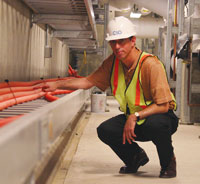IT from the Ground Up
UC Merced CIO Rich Kogut’s visions and plans from the
past three years will materialize as the first new University of California
campus in nearly 40 years officially opens in Merced, CA on September 5.

UC-Merced's Kogut: The advantage is: We have no legacy. The challenge is: We have no legacy.
You’ve been working toward the opening of the new UC Merced campus
this fall. How long have you been working on this project, and what are the
goals for IT? I came onboard in August 2002, so it’s been just
over three years. The goals for IT are, of course, the same as any campus has:
We have to support everything. But there are three cornerstone strategies we’re
trying to follow in implementing IT. First, we are very much trying to use a
flexible, open-standards-based infrastructure, so that we can allow freedom
of choice for the services that are going to be added later. We want to be able
to leverage new and emerging technologies without being locked in to any particular
solution or vendor, so it’s important to create a solid and open infrastructure
that we can build on. Second, we’re trying to provide service from the
user perspective, avoiding silos not only in the actual function, but also based
and structured around the user’s point of view. Part of that will be heavy
reliance on portal technology so that users can see everything they need, via
one location. We’re trying to structure our services so that students,
faculty, staff, or others have as unified an interface as possible. The third
cornerstone: to build in identity management and automated provisioning as a
fundamental part of the IT infrastructure. We want to automate as much as we
can from the start, and make it totally scalable.
You’re opening with 1,000 students and plans to scale up in coming
years. What types of programs will initially be offered on this campus?
Of those 1,000 students, some will be graduate students, some will be junior-year
transfers, and the majority will be freshmen. On the academic side, as well
as in IT, everyone is trying to take an integrated approach. In terms of academics,
that means a lot of interdisciplinary work. We’re not opening with standard
departments; there is no biology or Spanish department. We have three schools,
and majors are intended to be higher level, with the ability to select emphases…The
idea is to have as much interaction among our three schools as possible, to
prepare students for the cross-disciplinary challenges of the 21st century.
Will you connect to NLR, Internet2, or other research networks?
We are currently connected to CalREN (http://www.cenic.org), which, in turn,
is connected to virtually everything in the world. We now have 96 strands of
fiber connected to the CalREN backbone; we’ll be running multiple connections
to it. We’re currently running a 1-Gig connection for basic work, but
we will add a research link, as needed, that can go up to 10-Gig.
We're trying to use a flexible, open-standards-based infrastructure, so that we can allow freedom of choice for the services that are going to be added later.
Our goal is to have as close
to full coverage as possible. We have wireless APs funded in all our projects.
But, until we actually get all the buildings built, it will be hard to make
sure we have that full coverage. So, it may take a little time, but full coverage
is definitely our goal.
What are the advantages and challenges in working on technology infrastructure
planning from the ground up? The advantage is: We have no legacy. The
challenge is: We have no legacy. We have to put up things that will work, day
one; we don’t have existing systems to fall back on. So, the challenge
is to put in systems that are as close to state-of-the-art as we can get, without
pushing it so far that we might put in something that d'esn’t work. And
we have to build services that will scale to 25,000 students, though without
the resources [yet] of a 25,000-student university.
And the main advantage of working from the ground up? We can
choose the best systems—even those developed at other institutions that
can’t deploy them themselves because they have different divisions and
schools each running their own services. We can take the best practices and
deploy them campuswide.
After the opening of your new campus in a few days, how will your focus
change? We’ll continue to build out services, make them more
complete, and add in new technologies. The next two interesting challenges will
be unified communications—including VoIP—and digital video. We’ll
move into a completely network-based communications infrastructure with new
functionality, and integration of video, voice, e-mail, conferencing, directories,
and data that can be passed among all sorts of wireless devices. We’re
assuming that will all be happening, and in the next two or three years, we’ll
see software that’s going to make it really interesting.
BIOGRAPHICAL NOTE: Rich Kogut joined UC Merced as CIO
in 2002 to help build the nation's first new research university to debut in
the 21st century. Kogut brings more than 35 years experience in IT to the process,
including 10 years with Compagnie IBM in Paris, and long appointments at Brown
(RI) and Georgetown (DC) universities.